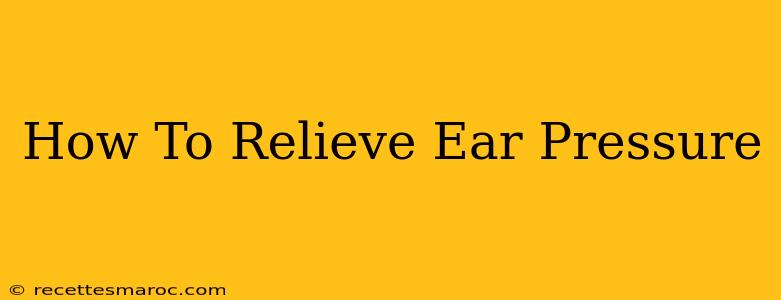Experiencing ear pressure? That uncomfortable, plugged-up feeling can be incredibly frustrating, whether it's caused by a flight, a cold, or something else entirely. Fortunately, there are several things you can do to relieve that pressure and get back to feeling comfortable. This guide will walk you through effective methods for relieving ear pressure, offering quick solutions and preventative measures.
Understanding Ear Pressure
Before diving into solutions, it's helpful to understand why ear pressure occurs. The middle ear is an air-filled space connected to the back of your throat via the Eustachian tube. This tube equalizes pressure between the middle ear and the outside environment. When this equalization process is disrupted, pressure builds up, leading to discomfort. Common causes include:
- Altitude changes (flying, driving in mountains): Rapid changes in altitude alter the air pressure outside your ears, causing an imbalance.
- Colds and allergies: Swelling and inflammation in the Eustachian tube can block it, preventing pressure equalization.
- Sinus infections: Inflammation in the sinuses can spread to the Eustachian tube, contributing to pressure buildup.
- Changes in barometric pressure: Severe weather systems can also affect ear pressure.
- Diving: Similar to flying, underwater pressure changes can cause ear discomfort.
Quick Relief Techniques for Ear Pressure
When ear pressure strikes, you'll want fast relief. Try these methods:
The Valsalva Maneuver:
This is a commonly recommended technique. Here's how to do it:
- Gently pinch your nostrils closed.
- Close your mouth.
- Try to gently blow air out of your nose as if you were blowing your nose. You should feel a popping sensation in your ears as the pressure equalizes.
- Important: Don't force it! If it doesn't work, stop and try again later. Forcing the maneuver can be harmful.
The Toynbee Maneuver:
This is a variation of the Valsalva maneuver:
- Close your mouth.
- Pinch your nostrils closed.
- Swallow repeatedly. This helps open the Eustachian tubes.
Yawning:
Yawning naturally opens the Eustachian tubes. Try yawning widely to help relieve pressure.
Chewing Gum or Sucking on Hard Candy:
The act of chewing or sucking stimulates the muscles involved in swallowing, potentially helping to open your Eustachian tubes.
Long-Term Strategies for Preventing Ear Pressure
While the above techniques offer immediate relief, preventing ear pressure is even better. Consider these strategies:
- Stay Hydrated: Drinking plenty of water helps thin mucus, preventing congestion that can block the Eustachian tubes.
- Decongestants: Over-the-counter decongestants can help reduce swelling and inflammation in the nasal passages and Eustachian tubes. Always follow the directions on the label.
- Avoid Smoke and Irritants: Smoke and other airborne irritants can exacerbate congestion and make ear pressure worse.
- Gentle Nasal Irrigation: Using a saline nasal rinse can help clear congestion and improve Eustachian tube function.
When to See a Doctor
While most ear pressure resolves on its own or with these simple remedies, see a doctor if you experience:
- Severe or persistent ear pain
- Hearing loss
- Fever
- Drainage from the ear
- Symptoms lasting longer than a few days
These symptoms could indicate a more serious underlying condition requiring medical attention.
Conclusion
Ear pressure can be a bothersome experience, but with the right techniques and preventive measures, you can effectively manage and relieve it. Remember to consult a doctor if you experience any concerning symptoms. Staying informed and proactive is key to maintaining healthy ears and avoiding discomfort.

